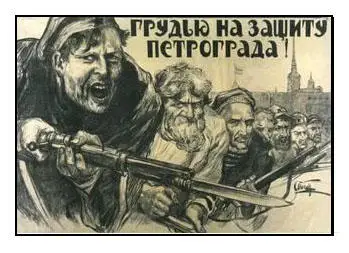Alexander Apsit
Alexander Petrovich Apsit was born in Riga on 25th March, 1880. He moved to Saint Petersburg in 1894 and attended art school and became a student of Lew Dmitriew-Kawkaski.
Aspit worked for various Russian magazines and on the outbreak of the First World War was employed by the government to design war posters. After the Bolshevik Revolution Apsit was commissioned by the State Publishing House to design revolutionary posters.
The Year of Proletarian Dictatorship was produced in October, 1918, for the first anniversary of the revolution. It shows the key elements of the revolutionary poster's imagery: a farmer with a red flag and scythe in the foreground, and a blacksmith with a hammer crushing the emblems of fallen capitalism - both as guards in front of a field of simple flags in the background an industrialized city and a rising sun.
Several posters were produced during the Russian Civil War with the intention of persuading young men to join the Red Army. The White Army was often portrayed as a monster.
After the war, he worked in Latvia as a book illustrator. In addition, he designed advertising posters and greeting cards, as well as the wrapping paper of chocolates and sweets from the company Vilhelms Ķuze. In 1939, Apsit moved to Nazi Germany, where he died in 1943.
Alexander Apsit died in Ludwigslust on 19th September, 1943.






Primary Sources
(1) Stephen Eskilson, Graphic History: A New History (2012)
Aspit's posters were well known because they were featured in runs of up to 50,000 making him the ostensible "father" of the Bolshevik poster.
Apsit demonstrated a good grasp of the Bolsheviks favoured theme of heroism in The Horse, Proletarian! In this image a cavalryman charges towards the viewer, his foreshortened horse and to billowing red flag seemingly having broken through the picture plane into the viewers space.
(2) David King, Red Star over Russia (2010)
The Bolsheviks equipped and mobilized agitational propaganda trains during the Civil War, sending them to all parts of Russia to inform the population about the ongoing struggles in defence of the revolution and to help organise lectures, meetings and discussions on the meaning of the new workers' state.
The first train named after Lenin, went into service on August 13, 1918. Others soon followed, bearing titles such as "October Revolution", "Red East", "Soviet Caucasus" and "Red Cossack". The carriages were famously decorated with paintings, graphic or satirical, on subjects that reflected the names of the trains and the places where they were headed.
Student Activities
Russian Revolution Simmulation
Bloody Sunday (Answer Commentary)
1905 Russian Revolution (Answer Commentary)
Russia and the First World War (Answer Commentary)
The Life and Death of Rasputin (Answer Commentary)
The Abdication of Tsar Nicholas II (Answer Commentary)
The Provisional Government (Answer Commentary)
The Kornilov Revolt (Answer Commentary)
The Bolsheviks (Answer Commentary)
The Bolshevik Revolution (Answer Commentary)
Classroom Activities by Subject
